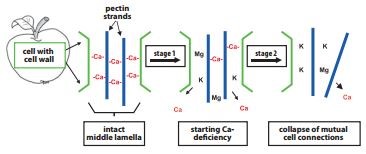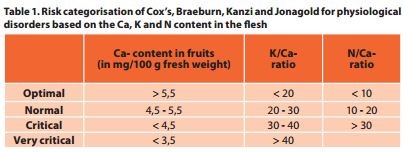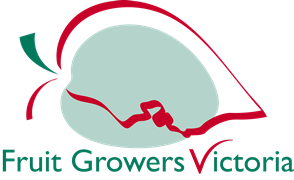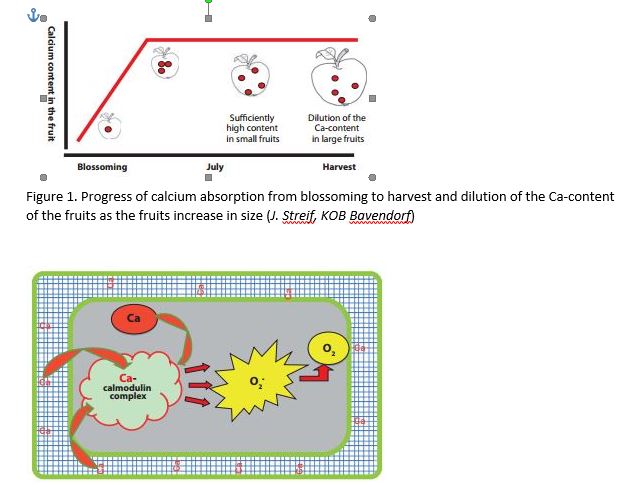Another function of calcium is that it encourages biological activity in the soil. The majority of soil organisms thrive best under slightly acidic soil conditions. In addition, calcium creates calcium bridges between the soil colloids, which is beneficial to the crumbliness of the soil. This improves the structure, the pore volume and permeability of soil. Depletion of calcium is caused by acidification of the soil, leaching and uptake into the fruit. Depletion caused by leaching per hectare per year is approximately 80 to 100 kg CaO with 600 to 900 mm precipitation. Depletion caused by soil acidification and uptake by the fruit is 170 kg CaO. So, on an annual basis, a total of 300 to 400 kg CaO per hectare is lost, which has to be replenished via maintenance fertilization.
Availability in the soil The total amount of freely available calcium in the soil does not always correspond to the soil pH, but is influenced by:
- The rocks that originally formed the soil and the type of soil (fraction of clay minerals);
- Calcium saturation of soil colloids. Lime is primarily a fertilizer. Only when the clay-humus complex has become saturated will there be enough free Ca2+ present in the soil moisture and therefore available for the plant;
- The presence of antagonists. The presence of other cations in particular such as ammonium, potassium, magnesium and sodium influence the calcium absorption;
- The extent of acidification of the soil. With increasing acidity, extra competition occurs between calcium and ions of aluminium (Al3+), hydrogen (H+) and manganese (Mn2+).
Calcium uptake
Calcium uptake places passively in the form of Ca2+ions via the root tips. The uptake depends on the root growth, soil temperature, soil moisture content and soil texture. Some 80 to 90% of the amount of calcium required in that year is taken by the tree from the soil and only 10 to 20% originates from the reserves in the wood. The calcium content in the leaves rises continually until the end of October. The fruits on the other hand are mainly supplied with calcium during the cell division phase, in other words during the first six weeks after blossoming. During the cell expansion phase the calcium concentration in the fruit is diluted as a result of fruit and shoot growth (see figure 1). Calcium uptake is stimulated by a moist soil and by sufficiently high transpiration and is negatively influenced by a dry, cold soil.
Distribution in the tree
The transport of calcium over large distances in the tree mainly takes place via the xylem vessels, that is to say in the transpiration flow. As their transpiration rate is much higher (ratio 1:10), leaves are supplied far better with calcium than the fruits. To transport calcium to the fruits, the inner bark (phloem) is important.
Due to the poor mobility of calcium in the phloem vessels no calcium travels from the leaves to the fruits. Transport over short distances from cell to cell is driven by a so-called ‘auxin pump’ mechanism. The auxin producing tissues in the plant have a hormonal sink effect and therefore have priority in the supply of nutrients and water. This mainly concerns young leaves found in the shoot tips and close to the fruits (rosette leaves) and the flowers and seeds in young fruits.
Trees that blossom well and exhibit a good fruit set and healthy, well developing leaves absorb more calcium in total than trees that flower badly which have low production and poor leaf quality. To a certain extent shoot growth is useful in supplying the entire plant and so the fruits, too, with calcium via the transpiration flow.
In the summer the young leaves, compete directly with the fruit close to the shoots for the supply of calcium. If growth is too strong and too prolonged, this may cause calcium to be diverted from the fruits in favour of the shoot tips. Even and balanced growth and production and halting growth at an early stage are the most important aspects in creating a good distribution of calcium throughout the tree.
In the plant
The presence of calcium in the plant has several functions.
- Calcium is an important building block of the protopectin, a sticky substance that plays an essential role as the ‘cement’ that holds the cells together and creates stability in the cell structure (see figure 3).
- Calcium binds phospholipids in the cell membranes and therefore pays an important contribution to the stability and functioning of the cell membranes, including transporting substances and the gas exchange between the cells.
- Calcium is part of a large number of enzymes that play a role in the ripening process. In this role calcium reduces the respiratory activity and ethylene production in the fruit. This retards the respiratory processes and ethylene induced ripening process that occurs post-harvest, or following the shelf life period (mealy apples).
- Calcium plays an important part in preventing environmental stress (heat, cold, wind, UV-B).
Stress causes the formation of free acid radicals at cellular level (see figure 2). Calcium binds with the protein calmodulin, which boosts the plant’s natural resistance. Using various substances –for example vitamin (α-Tocopherol) or antioxidative enzymes (catalase, superoxidedismutasis) –the plant’s own immune system neutralises free radicals (O2 -) and converts them into harmless oxygen molecules (O2). In this process the calcium bound in the cell walls or in the cell membranes plays a more important role than the free calcium in the cell plasma.
Figure 2. Stress resistance at cell level: neutralisation of free radicals by the calcium calmodulin complex (M. Schmitz-Eiberger, INRES - University of Bonn)

Figure 3. Occurrence of bitter pit through gradual instability of the middle lamella
Calcium deficiency
Calcium deficiency basically occurs in all varieties of fruit and principally in those parts of the plant that show little transpiration, i.e. mainly the fruits. Apples are particularly susceptible to calcium deficiency. On the one hand, due to the genetic makeup of the apple, but on the other hand as apples and because of commercial considerations, they are forced to grow larger than the normal fruit size for a specific variety.
Visible deficiency symptoms in the leaf are mainly seen in poorly bearing trees. From the early summer, pale - later chlorotic - patches appear at the tip of the leaves, ranging from small patches to entirely chlorotic leaf tips. Deficiency symptoms in fruits can occur with all types of fruit. Fruits with calcium deficiency ripen earlier, the decomposition of chlorophyll in the skin is encouraged (yellow discoloration) and the fruits have a low acidity and lack firmness. In addition, fruits with a calcium deficiency age quicker (senescence) and the flesh becomes soft sooner, mainly after a period of display at room temperature. The fruits also have a greater susceptibility to rotting; with apples infected by gloeosporium, with berries lower resistance to Botrytis and with stone fruit sensitivity to fruit rot.
On trees with a calcium deficiency any fruits damaged by hail, for example, will heal more slowly than those on trees with an adequate calcium level. With apples a calcium deficiency exaggerates all kinds of physiological disorders such as flesh browning, scald, Jonathan-spot, Elisespot, lenticel blotch and bitter pit.
Bitter pit is caused, in brief, by the following.
- With optimal calcium supplies, the protopectin (strands of pectin plus calcium) create calcium bridges which impart stability to the middle lamella (see figure 3).
- With low supplies of calcium, or displacement of Ca2+by Mg2+or K+ the mutual links between the cells are destabilised. The place of calcium is occupied by magnesium. As magnesium and potassium, contrary to calcium, lack the ability to bind cells, the cell structures collapse and turn brown. Magnesium binds to the sulphates and epsom salt is formed (magnesium sulphate). This gives the flesh a bitter flavour where the patches are visible (bitter pit). Risk of disorders A serious threat of disorders caused by calcium deficiency is present in:
- Orchards with too low calcium availability in the soil (low pH, little free calcium);
- Trees with rosette leaves damaged by frost or night frost or rosette leaves with poor nutrient level (‘Ca-pump’);
- Sensitive varieties (for example Kanzi, Braeburn, Cox’s, Boskoop, Elise and Junami >75 mm);
- Apples harvested too early (bitter pit) or too late (brownish flesh, gloeosporium);
- Fruits too large for the variety concerned;
- Newly planted trees with strong growth and trees with low production (unfavourable calcium distribution);
- Trees with a too high nitrogen, potassium or magnesium content. Relevant in the first place are low calcium, potassium, nitrogen and magnesium contents in the flesh. The mutual ratios in particular –especially the K/Ca and N/Ca ratio –are important indicators of the potential risk of physiological disorders in the fruits (see table 1). A few of these also partially occur while the fruit is still on the tree (bitter pit, lenticel blotch), others only after a period of storage (brown flesh, scald, storage pit, gloeosporium).

Disclaimer: The information contained in this publication is based on knowledge and understanding at the time of writing. However, while all reasonable efforts have been made to ensure that this information is correct and current, the information covered is subject to change. Fruit Growers Victoria Limited does not assume responsibility and hereby disclaims any express or implied liability whatsoever to any party for any loss or damage caused by errors or omissions, whether these errors or omissions result from negligence, accident or any other cause.
By Petar Bursac, Fruit Growers Vic. Ltd.



